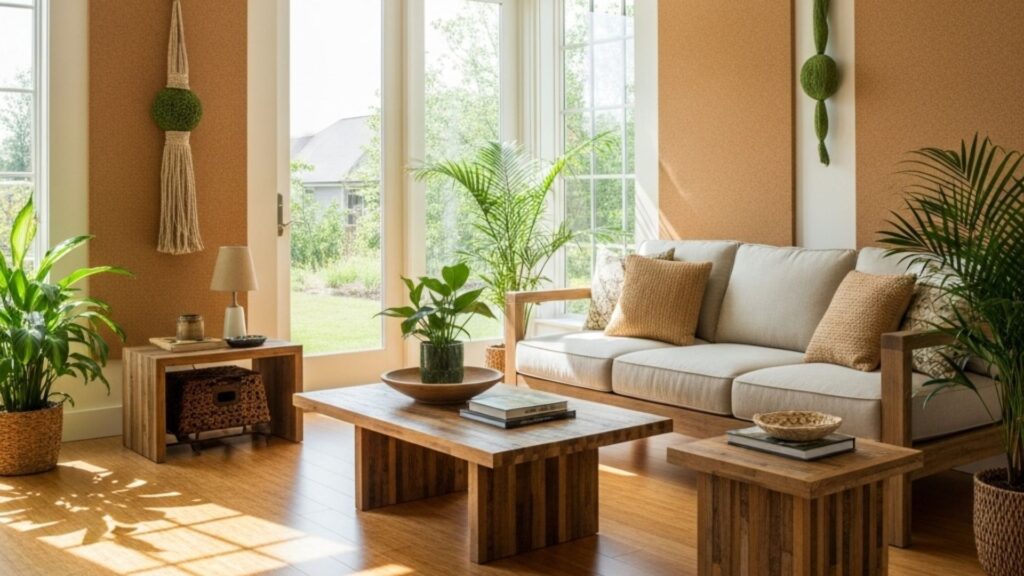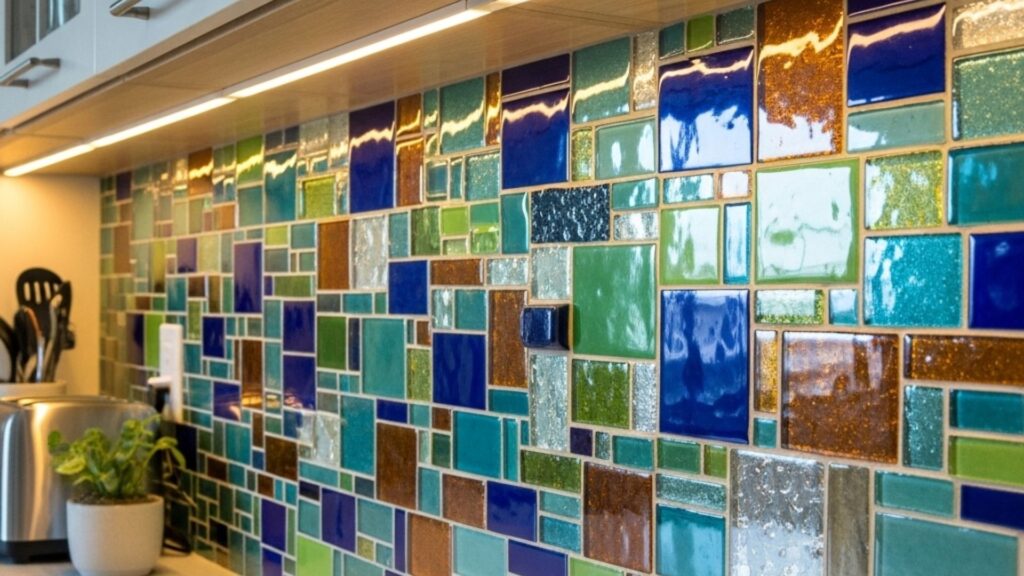The way we design and decorate our living spaces is no longer just about style or comfort—it is also about responsibility. As homeowners and designers become increasingly aware of environmental impact, the choice of materials plays a vital role in shaping interiors. Today, sustainable materials are not only eco-friendly but also sophisticated, versatile, and capable of transforming a space into something timeless.
When we talk about sustainability in interior design, it is not limited to recycled products or natural finishes. It involves a larger approach that includes durability, low environmental impact, ethical sourcing, and the ability to adapt to modern lifestyles. Let us explore some of the most impactful sustainable materials that are redefining the way modern interiors are created.

Table of Contents
1. Bamboo: Nature’s Fast-Growing Wonder
Bamboo is widely recognized as one of the most sustainable materials in modern design. It grows rapidly—maturing within three to five years—making it a renewable alternative to hardwood. Beyond sustainability, bamboo offers strength, durability, and a naturally elegant grain pattern. It adapts seamlessly to both minimal and luxury interiors, whether used for flooring, furniture, or cabinetry.
- It resists moisture and pests when properly treated.
- It is lighter than most hardwoods but tougher in density.
- It adds warmth to interiors without overpowering the aesthetic.
2. Reclaimed Wood: Giving Timber a Second Life
Reclaimed wood brings history and authenticity to interiors. It is sourced from old buildings, barns, or industrial structures, making every piece unique.
- Applications in Interiors: Feature walls, ceiling beams, dining tables, or shelving units crafted from reclaimed wood become statement pieces.
- Design Benefits: The aged patina, knots, and irregularities in reclaimed wood are impossible to replicate in new timber, offering a sense of warmth and individuality.
By choosing reclaimed wood, designers avoid the need for fresh logging while creating interiors that feel both rustic and refined.
3. Cork: Lightweight and Versatile
Cork is a highly renewable and flexible material that is slowly making its mark in interiors.
- Harvested from bark without harming the tree.
- Naturally soft and cushioned underfoot, ideal for families.
- Provides excellent acoustic and thermal insulation.
- Works well as flooring, wall panels, and decorative tiles.
- Earthy tones blend with both neutral and bold color schemes.
4. Recycled Metal: Industrial Yet Sustainable
| Property | Traditional Metal | Recycled Metal |
|---|---|---|
| Environmental Impact | Requires mining | Reduces waste & energy use |
| Design Look | Sleek, industrial | Same look with eco benefits |
| Durability | High | Equally high |
| Interior Applications | Railings, furniture, fixtures | Railings, fixtures, lighting |
Recycled metal reduces mining activities and cuts down energy use, making it a responsible design choice.
5. Natural Stone with Responsible Sourcing
Stone has long been associated with timeless luxury. While extraction can be resource-heavy, responsibly sourced stone ensures ethical practices. Granite, slate, and marble not only elevate interiors but also last for decades, reducing the need for replacements. For designers, the key lies in verifying sourcing credentials and balancing aesthetics with sustainability.
Advisory Tip: Choose suppliers that certify ethical quarrying practices and use finishes that enhance longevity.
6. Recycled Glass: From Waste to Wonder

Recycled glass has moved beyond simple utility to become a stylish element in interiors. It is created by melting down used glass and reforming it into tiles, countertops, and decorative panels.
- Applications in Interiors: Kitchen backsplashes, mosaic tiles, tabletops, and lighting features.
- Design Benefits: The translucent quality of glass enhances light and creates reflections that add depth and vibrancy to interiors.
Using recycled glass helps reduce landfill waste and provides designers with a material that blends creativity with sustainability.
7. Low-VOC Paints and Finishes
Paints and finishes are often overlooked in sustainable design discussions. Traditional paints release volatile organic compounds (VOCs) that affect indoor air quality. Low-VOC and natural paints are healthier for both residents and the environment.
- Applications in Interiors: Wall finishes, furniture coatings, and decorative accents.
- Design Benefits: Available in a wide range of colors, these paints provide flexibility in design without compromising health.
Modern interiors can achieve vibrant, bold, or soft tones while ensuring that the air remains safe and clean.
8. Jute and Natural Fibers: Textiles with Character
| Fiber Type | Benefits | Common Uses | Look & Feel |
|---|---|---|---|
| Jute | Biodegradable, affordable | Rugs, runners | Earthy, rustic |
| Hemp | Strong, durable | Upholstery, wall hangings | Neutral, natural |
| Organic Cotton | Soft, breathable | Curtains, cushions | Clean, fresh |
Pairing natural fabrics with contemporary furniture creates a balanced look that feels both modern and inviting.
9. Concrete Alternatives: Greener Choices
Concrete is widely used but has a high carbon footprint. Innovations such as fly-ash concrete or geopolymer concrete offer greener alternatives without compromising strength.
- Applications in Interiors: Flooring, countertops, furniture bases, and accent walls.
- Design Benefits: These alternatives have the same industrial appeal as traditional concrete but with reduced environmental impact.
Designers experimenting with concrete finishes can achieve modern aesthetics while staying conscious of sustainability.
10. Upcycled Materials: Creativity with Purpose
Upcycling transforms discarded items into valuable interior elements. From repurposed doors turned into headboards to old textiles reimagined as wall hangings, the possibilities are endless.
- Applications in Interiors: Decorative accessories, bespoke furniture, or statement art pieces.
- Design Benefits: Each upcycled piece carries a unique story, adding individuality and charm to interiors.
Upcycling encourages creativity while reducing waste, making it a favorite among modern designers.
The Future of Sustainable Interiors
The growing demand for sustainable materials is not just a passing trend—it is the future of interior design. Clients are becoming more conscious of the impact their choices have on the planet, and designers are responding with solutions that blend beauty, durability, and responsibility.
Sustainability in interiors does not mean compromising on style. In fact, it often results in more thoughtful, creative, and long-lasting designs. The key is to balance practicality with aesthetics, ensuring that every material used adds value to both the home and the environment.
Conclusion:
Sustainable materials are reshaping modern interiors by proving that eco-friendly design can be stylish, functional, and luxurious. From bamboo and cork to reclaimed wood and recycled glass, these materials bring a story, a purpose, and a unique character into our homes.
As designers and homeowners, embracing these materials is not just about creating beautiful spaces—it is about building interiors that reflect our values and contribute to a better future. The modern home is no longer just a personal sanctuary; it is a statement of responsibility towards the planet.